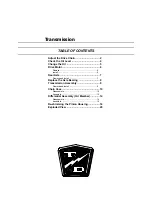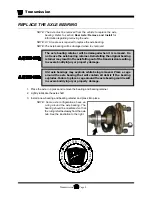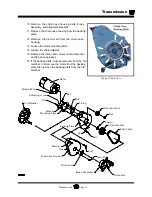
Motor Service
Motor
Page 4
5. Inspect the commutator for burn marks.
• Burn marks and/or raised commutator segments
90 or 180 degrees apart is evidence of a shorted
armature. A tool called a growler is required to
reliably test for a shorted armature.
6. Inspect the commutator for raised segments.
Raised segments could be a result of a stalled
motor or shorted armature. A tool called a growler
is required to reliably test for a shorted armature.
• If the armature is not shorted then the raised
segments can be removed by machining the
commutator. Do not machine the commutator
past the minimum diameter specified in
Service Limits
section. Refer to
Repair
Commutator
section for information regarding
machining the commutator.
7. Visually inspect the armature windings for burnt
insulation. Burnt insulation is a direct result of
motor overheating and could lead to a shorted
armature.
• If the insulation is cracked or burnt, then it is
recommend that the armature or motor be
replaced.
NOTE: If the armature has been burnt then there is a
good possibility that the field windings may
also be burnt. Symptoms indicating a shorted
field include high motor current, lack of power
and possibly excessive speed.
8. Using a growler, test the armature for shorts.
• If the armature is shorted, then we recommend
that the armature or motor be replaced.
9. Using the continuity function of digital multi meter,
check the continuity around the entire commutator
by placing one test lead against one of the
commutator segments and the other test lead
against all of the other segments one at a time.
There should be continuity around the entire
commutator. If any segment indicates an open
circuit, then the motor must be replaced.
10. Using the continuity function of digital multi meter,
check the continuity from any one of the
commutator segments and the armature frame. If
it is not an open circuit, then the armature is
shorted and the motor must be replaced.
11. Rotate the motor bearing(s) by hand.
• The bearing should not ‘freewheel’ but should
come to a smooth stop when rapidly spun by
hand. If the bearing freewheels, then grease is
no longer present in the bearing and it must be
replaced. Refer to
Replacing the Bearings
section for information regarding replacing the
armature bearings.
• Feel for any roughness when the bearing is
rotated. If any roughness or grinding is noticed
then the bearing must be replaced. Refer to
Replacing the Bearings
section for
information regarding replacing the armature
bearings.
Assembly
NOTE: If this is an enclosed motor on a vehicle with
a Power Traction primary reduction, then it
is recommended to replace the armature
shaft seal any time the motor is
disassembled.
1. Push the motor brushes just far enough out of the
brush holder so that the brush springs hold them
in place away from the commutator. See the
illustration to the right.
2. Install the rear motor housing to the stator housing.
3. Lightly grease the outside diameter of the armature
bearings.
4. Insert the armature through the stator housing and
seat the bearing into the rear housing.
5. If equipped with armature retaining screws, install
and tighten them at this time.
6. If this is an enclosed motor, lightly grease the
armature shaft seal and install the front motor
housing.
NOTE: If the vehicle is equipped with a belt type
primary reduction then the spring on the
motor seal should be removed. Failure to
remove the spring may result in a high pitched
squeal from the seal.
7. Push the motor brushes into the brush holder until
the brush spring snaps into place. Be certain that
the spring does not rest up against the brush wire.
See the illustrations below.
Typical burn mark on a shorted armature
Summary of Contents for AN 171
Page 2: ......
Page 12: ...TAYLOR DUNN...
Page 26: ...TAYLOR DUNN...
Page 42: ...TAYLOR DUNN...
Page 50: ...TAYLOR DUNN...
Page 51: ...TABLE OF CONTENTS Throttle Linkage Adjustments 2 Throttle Linkage...
Page 60: ...TAYLOR DUNN...
Page 79: ...Transmission Transmission Page 19...
Page 80: ...Transmission Transmission Page 20 EXPLODED VIEW...
Page 94: ...TAYLOR DUNN...
Page 150: ...TAYLOR DUNN...
Page 152: ...Illustrated Parts Parts Page 2 Front Axle...
Page 154: ...Illustrated Parts Parts Page 4 Front Tire...
Page 156: ...Illustrated Parts Parts Page 6 Front Fork 7 10 Fork Collar in frame 1 2 4 5 5 4 3 6...
Page 158: ...Illustrated Parts Parts Page 8 Steering Linkage SC...
Page 159: ......
Page 160: ...Illustrated Parts Parts Page 10 Steering Linkage AN...
Page 164: ...Illustrated Parts Parts Page 14 Throttle Linkage 3 1 2 4 5 6 6 6 7 8 8 9 10 9 10...
Page 174: ...Illustrated Parts Parts Page 24 Power Traction...
Page 176: ...Illustrated Parts Parts Page 26 Differential...
Page 178: ...Illustrated Parts Parts Page 28 Brake...
Page 180: ...Illustrated Parts Parts Page 30 Rear Axle...
Page 182: ...Illustrated Parts Parts Page 32 Rear Tires 10 Ref wheel hub 1 2 5 assembly 4 3 6 7 8 9...
Page 184: ...Illustrated Parts Parts Page 34 Control Panel standard...
Page 186: ...Illustrated Parts Parts Page 36 Control Panel 40 bed...
Page 188: ...Illustrated Parts Parts Page 38 Instruments Gauges Model SC VKRZQ Model SC VKRZQ...
Page 190: ...Illustrated Parts Parts Page 40 Batteries Main positive Main negative 1 1 1 2 2 3 3 3 4 5 6 7...
Page 192: ...Illustrated Parts Parts Page 42 Decals...
Page 196: ...Illustrated Parts Parts Page 46 Miscellaneous Frame and Body AN...
Page 198: ...TAYLOR DUNN...















































